If you’d told me ten years ago that I could hop in the car in Philadelphia, point the hood north, and be into world‑class salmon by that afternoon, I would’ve smiled politely and started searching flights to Anchorage. I did make those flights—to Alaska, to Iceland, to Scotland—and I’ll never forget those trips. But my gateway to Great Lakes kings, coho, and steelhead wasn’t a boarding pass. It was a friend named Stan who called one fall and said, “Come up to the Salmon River with me.” I went. I caught my first New York salmon that trip. And I’ve been back almost every year since.
This past fall I finally shared the obsession. I talked my brother, my dad, and my father‑in‑law into joining me for a quick two‑night run. It was a short, mid‑week mission—drive up Monday, home by Wednesday—but it delivered everything I love about this fishery: big fish, crowded pools that somehow spill over with camaraderie, quiet bends where salmon tails slice the surface at dawn, and the kind of stories you retell at dinner, then again at the bar, and then again the next time someone says, “Wait—you can catch salmon in New York?”
The River & the Runs (What Makes This Place Special)
The Salmon River flows out of Lighthouse Hill Dam near Altmar and winds past Pulaski to Lake Ontario, drawing fall runs of Chinook (“king”) and coho salmon, with steelhead and brown trout arriving behind them. The river is the centerpiece of New York’s Lake Ontario salmonid program; the state’s Salmon River Fish Hatchery, built in 1980, raises Chinook, coho, steelhead, and browns that sustain this fishery. Department of Environmental Conservation
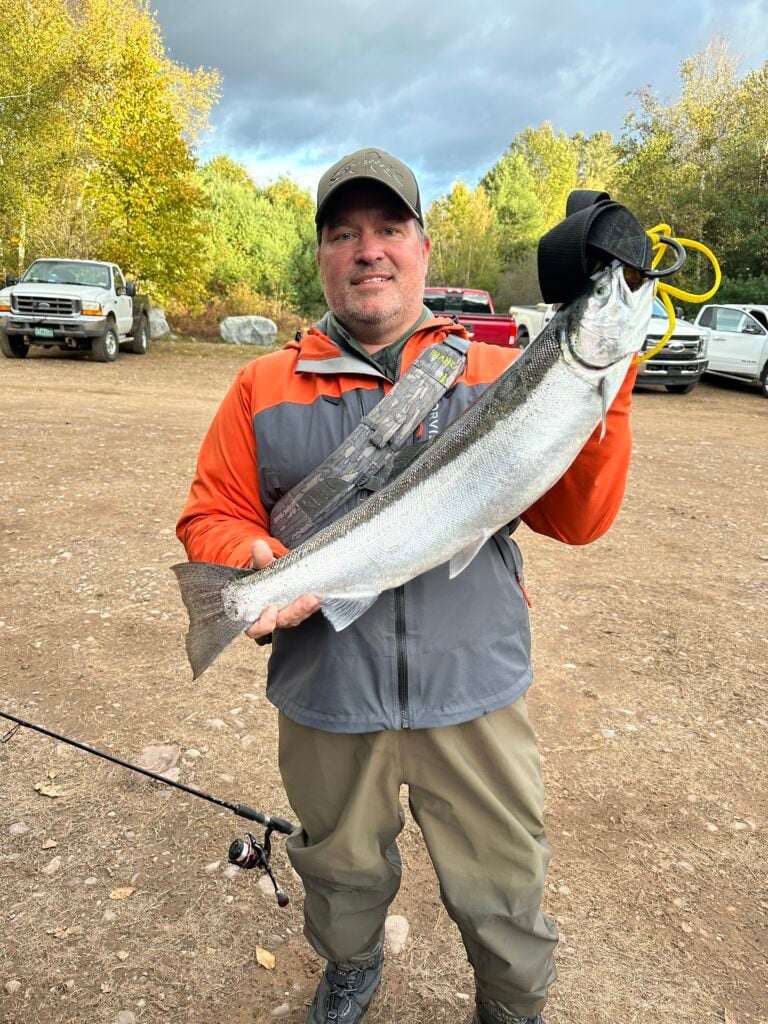
Timing matters. Typically, tributary fishing for Chinook and coho begins in early September and runs through early November, with the peak often in the first half of October. Steelhead enter in the fall and keep the party going from about November through spring, with browns also in the mix in the fall. If you’re trying to thread the needle for kings but still want a shot at chrome steelhead, late October is a beautiful overlap. Department of Environmental Conservation
Two practical notes about conditions and rules that shape your day:
- Flows are managed by the hydropower operation at Lighthouse Hill. Watch the USGS Pineville gauge to see what’s actually in the channel and check Brookfield Renewable’s SafeWaters site for planned releases. Baseflows are seasonally adjusted—during drought years DEC may recommend conserving water and delaying increases—so it pays to check before you leave. USGS Water Data
- Hours and gear are regulated. During the fall tributary season, fishing at night is prohibited on Lake Ontario tributaries, including the Salmon River (generally ½ hour after sunset to ½ hour before sunrise). The Salmon River also has its own special regulations and Fly Zones with specific tackle rules and hours. Always review the current DEC page before your trip. Department of Environmental Conservation
Where We Stayed: A Fisherman‑Friendly Base in Altmar
We made the Tailwater Lodge our base. It’s right on the river in Altmar—one of those places where you can pull on waders in your room, shuffle downstairs with coffee, and be swinging flies in minutes. Tailwater is an Orvis‑endorsed property that leans into the fishing crowd: boot dryers, gear talk at breakfast, and a hot tub that hits the soul after a cold day in the current. I can vouch for the restaurant and bar, too. Tailwater Lodge
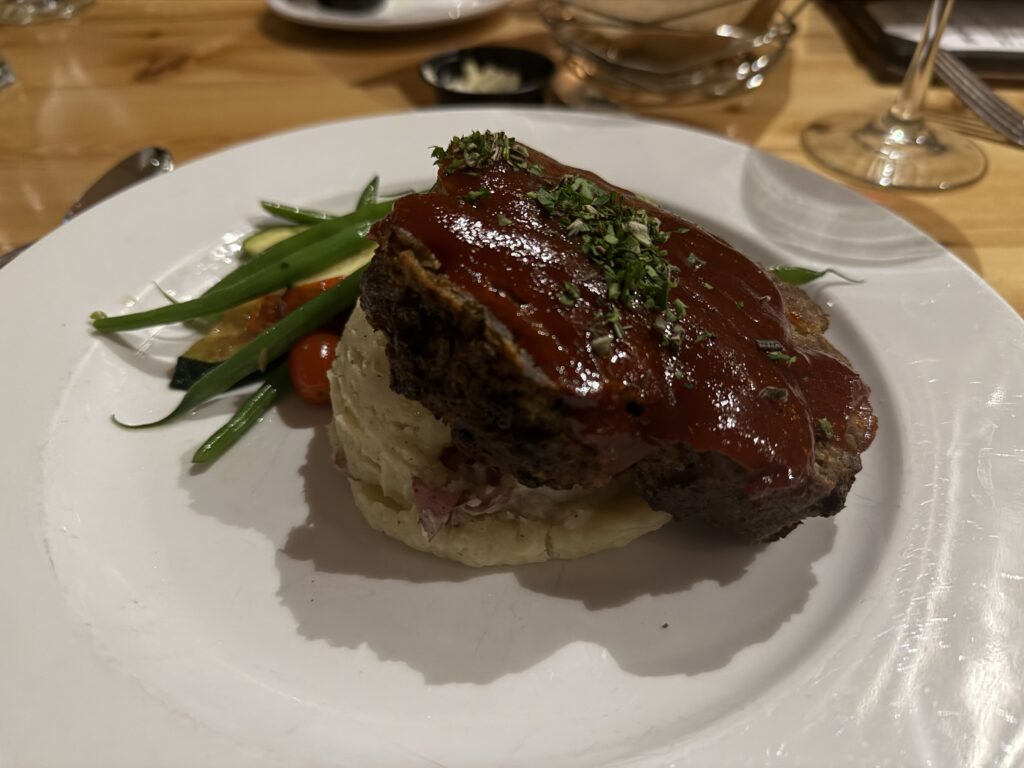
Our Two‑Night Playbook
Monday: Travel, Scout, and Teach
From Philly it’s a manageable four‑to‑five‑hour drive if traffic behaves. We rolled into Altmar around 3:30 p.m., checked in, and hustled straight down to the river behind the lodge. I’d never fished that specific stretch, and there was a good bend downriver that looked fishy—but it was crowded—so we gave people space and slid to calmer seams. The water was low and clear, which would be the theme of the trip. That first evening turned into more of a clinic for my dad, my father‑in‑law, and my brother on Salmon River drifts: egg patterns (white, pink, orange) under weight, 8‑weight rods, and rotating tippets—12‑, 10‑, even 8‑pound when we needed finesse. No grabs for us, but we sharpened the drift and read the water. Dinner and early alarms followed.
Tuesday: Dark Hike to the Sportsman’s Pool, Big Lessons
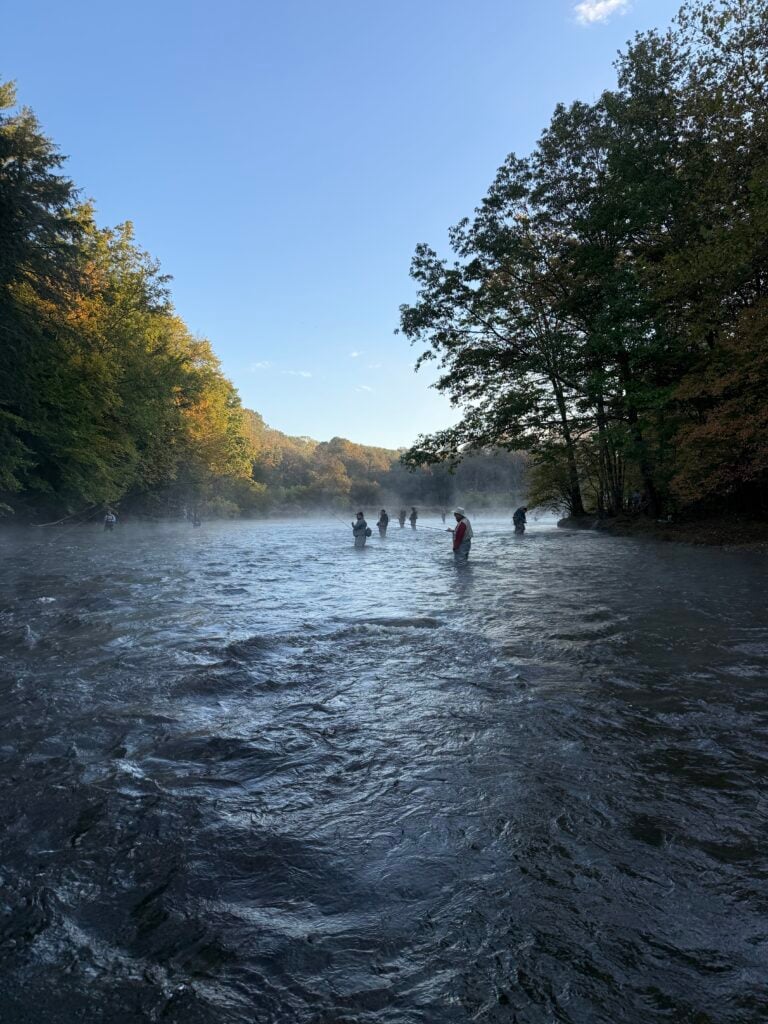
Alarms at 4:30 a.m. We drove to Sportsman’s Pool—a place I fish a lot (many folks say “Sportsman’s Hole,” but the maps call it Sportsman’s Pool). We hiked in by headlamp, got to the water before first light, and I felt my stomach dip. I’d never seen it so skinny. In the half‑dark I was trying to remember contours and position everyone safely.
As sunrise bled through the trees, more anglers appeared and fish began to move. Kings and cohos porpoised and pushed upstream. I hooked a few—enough to feel that heavy, head‑throb run—only to lose them to a spit hook or a quick break. No matter. My brother connected, and then my father‑in‑law, netting for the first time, was suddenly thrust into an unplanned master class. The bank became a chorus giving him netting advice, he timed it right, scooped, and my brother lifted his first coho salmon from New York. We fished hard into afternoon with scattered action and headed back to the lodge for a reset.
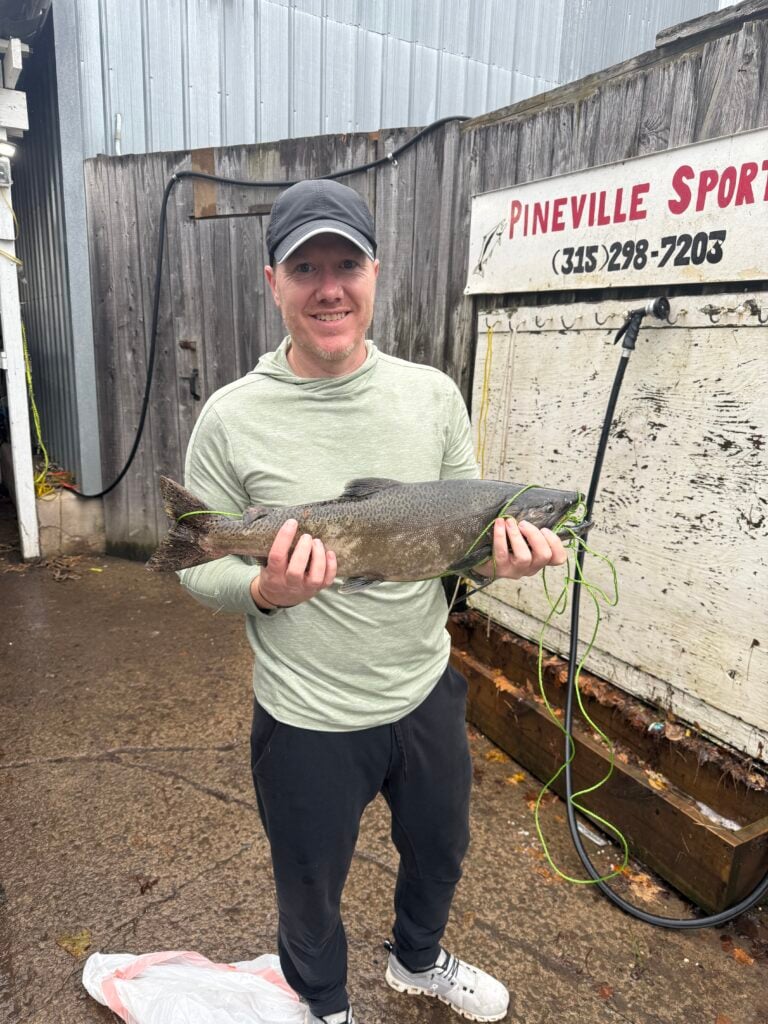
But we noticed something important at Sportsman’s earlier—a guy was hooking salmon every 10–15 minutes. What was he doing different? Blue eggs, he said. My egg boxes were loaded with oranges and pinks and whites. My blue eggs were…back at the hotel.
Lesson learned: bring all the colors.
At dusk, we ran behind the lodge again to scout for the next day. Same story: clear, low, picky fish. Everyone was working a tight and fast bend, so we decided that would be our spot the next morning.
(If you’re looking at a map, DEC’s “Popular Salmon River Fishing Locations” shows Sportsman’s Pool, Trestle Pool, the Town/Short Bridge Pool, and more—handy for planning.) Department of Environmental Conservation
Wednesday: Dawn Tails, Blue Eggs, Tight Lines
The busy bend behind the hotel was claimed long before legal fishing hours (remember, on this river you can’t fish earlier than ½ hour before sunrise), so I scouted farther downstream. I found a small cut where the current kissed a bend and slowed. Even in the dim gray I could see them—salmon tails everywhere, waving like flags in the shallows.
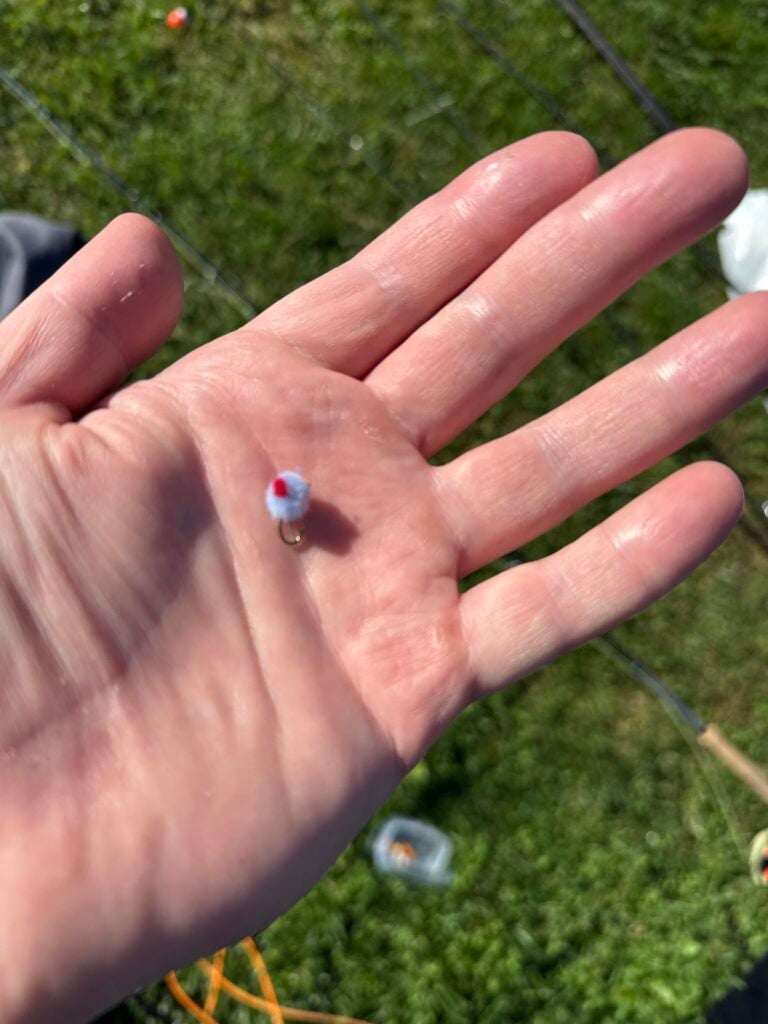
When the clock said go, I tied on a blue egg and went to work. First drift: fish on. Ten minutes later, just as a kind‑hearted angler with a net was ready to help, the fish vaulted, cleared the net, and popped the leader. Welcome to kings.
I retied. A few drifts later, I was tight again, only to part the line. That low, clear water pushed me down into lighter tippet, and these fish didn’t play nice. Right there I committed to a more deliberate presentation: a tight‑line drift—basically Euro‑nymphing for salmon—leader only in the water, fly line off the surface, a touch of split shot, and the egg ticking bottom. Keep the line tight, feel everything, and guide that drift with the rod tip.
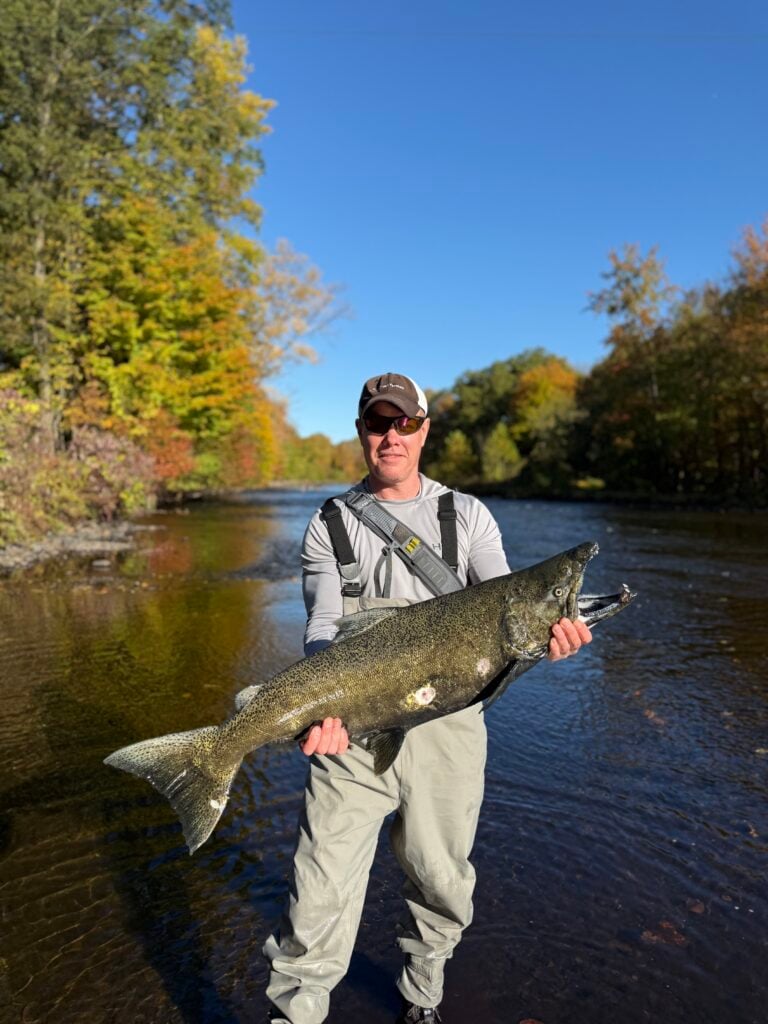
My brother showed up then, and within minutes I was tight again. This time I’d bumped my tippet to a slightly stronger fluorocarbon. The fish dug, tore across the pool, surged downstream, and came back up the near seam. Several false net attempts later, we got it—a big Chinook, heavy as a cinder block and twice as angry. We whooped. My brother slid into the slot next and promptly hooked a freight train that peeled 50 yards of line and said goodbye. That’s salmon fishing on the Salmon: heartbreak and high‑fives on the same cast.
How We Rigged and Fished (What Worked and Why)
Rod & line. An 8‑weight fly rod is the sweet spot for kings and cohos; for steelhead, 7–8 works well. Switch rods can be handy for reaching and mending in bigger pools. Studded boots and a wading staff are not luxuries when the flows bump.
Leader & tippet. In clear, low water I rotated between ~12‑, 10‑, and even 8‑pound fluorocarbon. If you tend to horse fish (guilty), that lighter stuff will punish you; upsize when you can, especially if you’re near wood or ledges.
Flies. Egg patterns in white, pink, orange—and yes, pack blue—were our confidence flies. When fish stack in travel lanes, the right color and a natural drift can mean the difference between a bump and an eat.
Presentation. Two approaches stood out:
- Classic dead‑drift under weight with the occasional indicator if the seam demanded it. Adjust split shot until you’re just ticking.
- Tight‑line/Euro‑style drift when the river was too low and clear for long casts. Keep only clear leader in the water, guide the drift with the rod tip, and control speed. This felt invisible to skittish fish and kept us in better contact when they mouthed an egg.
Where to stand. In low flows, fish compress into small depressions, seams off gravel bars, and the head/tail of cuts. If you don’t know a stretch, wait for light and watch—tails will show you where they are.
Netting and teamwork. Communicate with neighbors, especially in the crowds. If someone offers to net (or you’re asked to net), talk through the plan first: fish upstream of the net, head up, one clean scoop.
A Quick Guide to Spots, Access & Etiquette
Named pools: If you’re new, study a map the night before. Sportsman’s Pool, the Town/Short Bridge Pool, Trestle Pool, the Black Hole, and the Fly Zones are fixtures on DEC’s public map and the agency’s Salmon River page. These names make it easier to plan where to park and how far you’ll walk. Department of Environmental Conservation
Fly Zones: Upper and Lower Fly Zones have specific seasons, tackle rules, and hours. They’re great places to learn in a more fly‑centric environment—but know the regulations before you go. Department of Environmental Conservation
Douglaston Salmon Run (DSR): The lowest stretch near the estuary is private, fee‑access water. Day passes are required and pricing and angler limits vary by season; plan ahead if you want to fish it. Douglaston Salmon Run
Etiquette: This river gets busy. Slide in with a greeting, ask how folks are working the drift, and leave enough room to cast and fight fish. When someone hooks up, give them path to maneuver; you’ll want the same courtesy in five minutes.
Safety, Flows & Rules You Should Actually Read
- Check flows. Between dam management and rain, the river can change overnight. I use USGS Pineville to see what’s real and Brookfield SafeWaters for release info. USGS Water Data
- Respect hours & rig rules. In the fall tributary season, fishing at night is prohibited; Fly Zones have posted open seasons, hours, and tackle restrictions, including leader and weight placement rules. DEC maintains a single page with all the Salmon River and Lake Ontario tributary regulations—save it to your phone. Department of Environmental Conservation
- Wading. Even at “low,” the Salmon can be pushy. Felt + studs and a wading staff are wise. Ice builds fast as fall slides toward winter; step carefully. (Tailwater’s Orvis page reminds guests to bring studs and a staff—smart advice.)
When to Go (and How to Plan a Short Trip)
If your target is kings/coho, circle mid‑September through late October, with the first half of October historically hot. If you’re itching for steelhead, late October into November is fantastic—and the fish stick around all winter, with spring drop‑backs in April. For browns, think September–November. Adjust on water and weather; runs shift with wind, temperature, and rain. Department of Environmental Conservation
For a quick two‑nighter like ours:
- Travel Monday, fish evening. Scout, watch, pick a morning plan.
- Pre‑dawn Tuesday: Hike in early (you can arrive before legal hours, you just can’t fish yet), stake a seam, and be ready at first light. Rotate flies and angles; relocate by mid‑morning if pressure beats you to your water. Department of Environmental Conservation
- Wednesday dawn: Try a fresh stretch—or double down where you saw tails. We capitalized mid‑week when a popular bend filled up before dawn by sliding just downstream into a subtle cut that was loaded.
Build in time to eat, re‑rig, and—if you choose Tailwater—soak in the hot tub before doing it again. Your legs will thank you. Tailwater Lodge
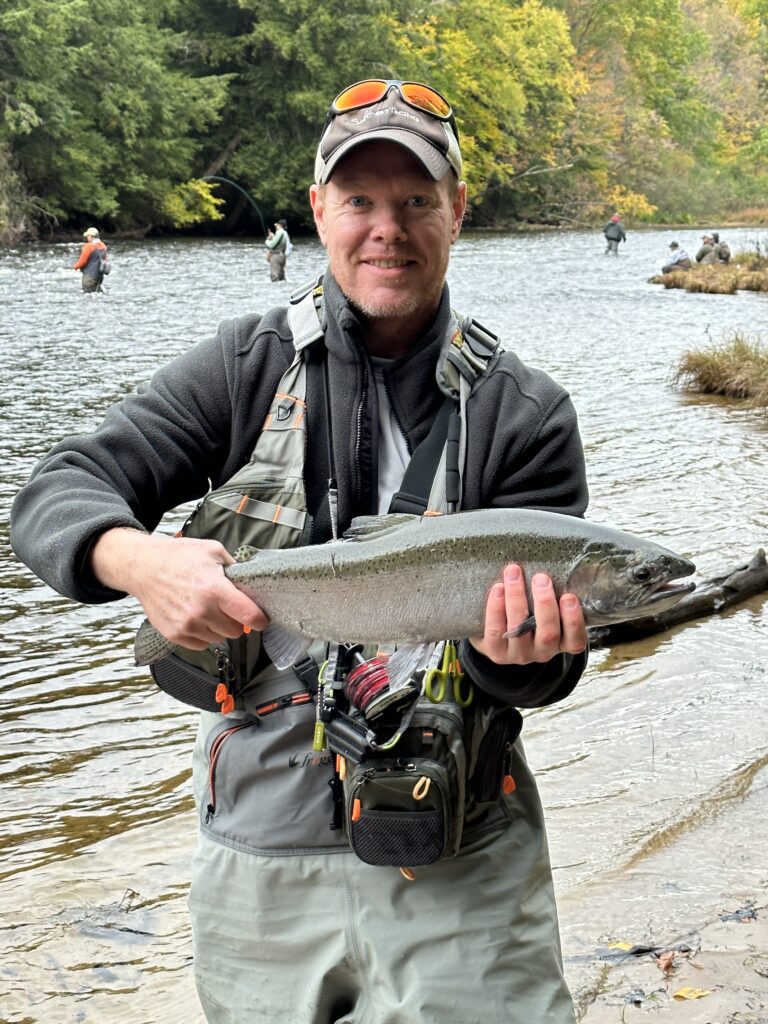
What I’ll Remember (and What I’ll Do Differently)
The moments stick: teaching my dad the drift while the river turned copper in the evening; the entire bank coaching my father‑in‑law through his first net job; my brother’s coho cartwheeling to the chorus of “keep the head up!” across the pool; a big chinook bulldogging down a ledge and refusing to quit.
Two lessons I’ll carry into the next run:
- Color counts. Orange and pink get the headlines, but blue eggs were the difference for us on day two. Pack them all.
- Stealth and contact. When the river drops and clears, I fish shorter, put only leader in the water, and keep a taut connection to the fly. That tight‑line approach turned looks into eats when traditional indicator drifts felt too loud.
And finally, a reminder I wish someone had hammered into me my very first year: you don’t have to fly across a continent to feel a king rip 50 yards of line and remind you who’s boss. Sometimes the best kind of “destination” is the one you can reach on a tank of gas.
If you’ve ever wondered whether the Salmon River lives up to the stories, here’s my take after a decade of fall pilgrimages: it does. Bring your patience, your sense of humor, and a few blue eggs—you’ll be just fine.
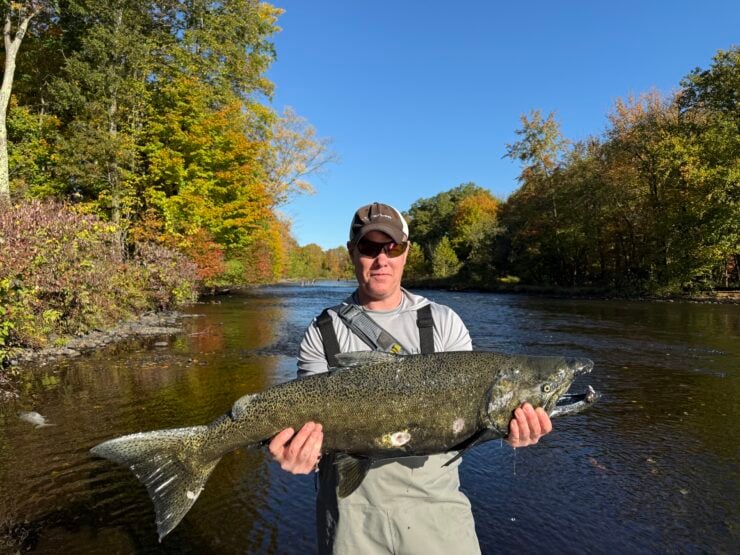

Add comment